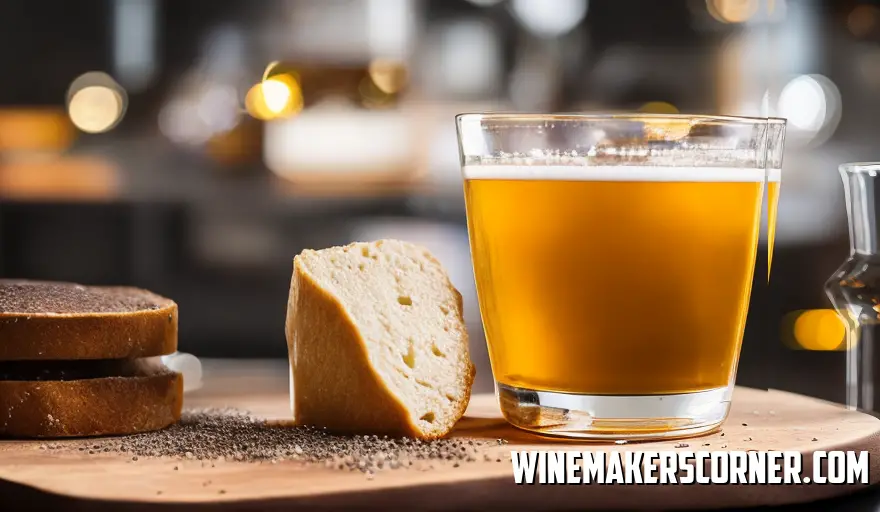The world of wine fermentation is nothing short of mesmerizing – its a delicate balance between science and art where even the smallest details matter greatly in producing that ideal glass of vino. As a grape grower turned wine enthusiast theres nothing quite like savoring every sip knowing that each step in creating this elixir was thoughtfully considered with utmost attention to detail. But when exactly can you be sure that your bottle is ready for uncorking? Don’t fret; we’ve got you covered in this article where we’ll explore everything there is to know about fermentation and help you determine when your wine is at its peak potential – lets begin!
Understanding the Fermentation Process
Mastering The Art Of Wine Fermentation requires patience, knowledge, and a thorough understanding of the process involved. Its essential to know when your wine has reached its optimum point correctly. This piece will delve into the complexities present within Wine Fermentation guiding you on how best you can identify when your winemaking efforts have been successful .
Fundamentally speaking Wine Fermentation involves converting Sugar into Alcohol through Yeast; “voila ” this magical transformation gives birth to complex fragrances & flavors we all love so much within Fine Wines. Nevertheless its not as easy as waiting around for the process to finalize; Temperature plays a crucial role in the Fermentation Process too – Yeast can stop working completely if it gets too cold or start developing undesirable aromas when things get excessively hot. Striking the right balance between both is vital for ensuring that your wine has character and soul .
Monitoring your wine during fermentation is critical; this will help you keep track of yeast activity- an essential sign of how well things are going! As bubbles decrease in frequency it becomes apparent that Fermentation is slowing down. Specific Gravity measurements’ usage allows one more step to be taken towards confirming progress. To track the changes in sugar content during fermentation accurately, a hydrometer comes in handy.
When the specific gravity remains constant for several days running, that’s an indication that fermentation is over. However simple this process may seem; there’s more to be done – using your senses! Judging from the taste and smell of your brew can give some insight into whether or not your wine has reached its full potential.
A balanced flavor profile with an excellent aroma are sure signs that you’ve accomplished something worth celebrating- Bravo! Understanding the importance of patience and attentiveness when fermenting your grapes will yield fantastic homemade wines worth savoring- closely monitor temperature changes by observing bubble activity- also pay attention to specific gravity measurements.
Monitoring Your Wine’s Progress
If mastering wine fermentation is on your radar its essential to monitor progress closely by tracking several key indicators. This article outlines these indicators with valuable insights into the fermentation process.
First on our list are bubbles – an excellent indication of active yeast working its magic by converting sugar into alcohol and carbon dioxide.
Although bubble activity declines gradually over time it signals that fermentation is near completion at this stage. Consistent temperatures are also crucial for optimal yeast performance since fluctuations can result in less than ideal or incomplete fermentations. Investing in quality thermometers facilitates regular monitoring for timely adjustments when necessary.
Finally color changes in fermenting wines reveal valuable information about their maturity level over time. A shift from cloudy to clear signifies suspended particles settling at the bottom of the vessel – indicating sustained progress towards optimum maturation for great tasting wines! Remember to pay attention to aroma! A well-fermented wine should have fragrances that are pleasing to the nose – fruity or floral notes or hints of spices depending on the grape variety used. If you notice any unpleasant odors like rotten eggs or vinegar during fermentation stoppage may be caused by issues with the process. Furthermore, it’s critical to listen to your taste buds! Periodically tasting your fermenting wine allows you to keep track of its progress and make changes if necessary over time it will evolve into a more complex flavor characteristic of a matured wine once sugar levels fall and alcohol increases.
To conclude,maintaining vigilance over essential elements such as bubble activity consistency in temperature color alterations fragrance growth,and changes in taste will go a long way toward determining when your homemade wine has reached its peak quality level.Along with meticulousness and patience,you can soon become a master at recognizing precisely when your fermented product is ready!
Recognizing Common Fermentation Issues
To create the perfect brew winemakers need an eagle eyed approach during fermentation and keenness towards identifying any common problems that might arise during this crucial phase. Temperature fluctuations can cause quite a few complications when making wine: excessively high temperatures leading to incomplete fermentations while extremely low temperatures delaying the entire process! Winemakers ought to monitor their fermenting mix closely in order maintain steady temperature conditions throughout.
Nutrient deficiencies in yeast are another cause for concern among brewers as inadequate levels of nitrogen or other important elements can result in subpar ferments, which may not achieve the desired results.
Ensuring the must has adequate nutrient levels before starting fermentation is an essential step.
One of the earliest signs that things may be going awry during fermentation is when your wine emanates unpleasant odours. If your brew smells like rotten eggs it could indicate nutrient deficiencies and stressed yeast cells – so make sure to note it down immediately. Other smells could point to bacterial spoilage or oxidation issues which need prompt attention to prevent any further harm to your end product.
Achieving success in winemaking demands prompt attention to any issues that may arise throughout the fermentation process. Whether it’s adjusting nutrients or implementing proper sanitation practices, taking corrective measures such as racking can help address these challenges. Furthermore, neglecting visual cues may cause setbacks with your wine’s progress. While a foamy layer atop fermenting must is typical, excessive foam could signal extremely strong fermentation which requires temperature control or nutrient adjustments to bring under control.
To summarize key considerations for mastering the art of wine fermentation: consistent temperatures and nutrients are crucial factors; unwanted odors and abnormal visual cues require prompt attention; quickly recognizing and solving issues early on brings forth superior results!
The Role of Yeast in Wine Fermentation
Wine lovers are familiar with the unique taste associated with fermented grape juice and appreciate its complexities. Yeast plays an instrumental role in this transformation making it essential for budding winemakers to understand how it operates to create precise results and achieve optimal refinement. In simple terms yeasts are unicellular organisms that feed on sugar creating alcohol as a byproduct – Saccharomyces cerevisiae strains being used widely for fermentation in winemaking processes globally.
These microscopic creatures break down grape sugars into ethanol (alcohol) and carbon dioxide via carefully monitored conditions involving temperatures between 60 90°F (15 32°C). Too low leads to slow or stalled fermentation while too high could destroy all yeast activity altogether or produce undesirable aftertastes with serious implications on overall quality in any produced batch of wine. Do you have a sense of when your wine is finished fermenting? An excellent way to detect the end stages is by observing bubbles – they indicate active fermentation as CO2 escapes from within.
Once bubbles become few and far between or stop altogether, that’s usually a good sign it’s time for testing! Another great tool is using a hydrometer, where readings showing lowering specific gravity indicates yeast is feasting on that sugar like there’s no tomorrow (because there won’t be once the alcohol gets going). If readings stay constant over successive days, then fermentation has likely completed its course! Lastly, don’t forget the taste test. Alcohol production leads to sweetness decreasing while sourness increases – so if everything tastes nicely balanced? Your wine may be finished!
To sum up: yeast makes all our dreams possible by converting sugars into alcohol and CO2 under optimal temperatures; keeping track of bubble activity, hydrometer readings and taste are pivotal indicators towards knowing when your beverage has fermented thoroughly. Perfecting these steps in turn means having perfectly crafted wines every time. Climate change can no longer be wished away; it’s an evident reality! Climate scientists have proven beyond any reasonable doubt how rapidly temperatures keep soaring high globally.
Glaciers across the globe melt at an unprecedented rate resulting in shocking rises in sea levels and extreme climatic conditions like heavy flooding or terrifying hurricanes which have become commonplace incidents affecting millions worldwide. Unfortunately, individuals without sufficient means to respond feel the brunt of these devastating circumstances majorly low-income earners.
Testing Your Wine’s Specific Gravity
Becoming proficient at creating decadent homemade wines requires discipline, skill, and a keen eye for detail. Successfully mastering wine fermentation mandates keeping track of various factors along the way- the key being monitoring specific gravity accurately.
As yeasts consume sugars while producing alcohol during fermentation stages- there will be observable changes affecting liquid density measurements within this timeframe period.
Luckily enough using a hydrometer can greatly assist in measuring these changes precisely. To begin tracking first take your initial reading before commencing the fermentation process. Regularly track specific gravity throughout every step and observe gradual drops in numbers as sugars progressively convert to alcohol.
Its critical to be diligent and attentive throughout this whole process to provide optimal results. Once several consecutive days have passed with stable hydrometer readings – congratulations! Your wine has officially reached its final specific gravity level – indicating that fermentation has come to an end ultimately resulting in a beautiful homemade wine that you should enjoy! With confidence under your belt, it’s time to tackle the next steps: racking, aging, and bottling your delightful creation. In short, mastering specific gravity measurements during wine fermentation is key for producing exceptional wines again and again.
So dust off that hydrometer and embark on a journey where science and artistry intersect in crafting liquid masterpieces!
Assessing Your Wine’s Taste and Aroma
Making wine requires skillful artistry that involves fermentation techniques that can be both fascinating and intricate simultaneously. As someone who desires to become skilled at making homemade wines, learning how to recognize when fermentation is complete is essential since it relies primarily on evaluating aroma and taste elements in your brew.
Let us first discuss tasting notes: sweetness, acidity, tannins, alcohol content are four vital components that require careful consideration before achieving perfectly balanced flavors among them.
To evaluate correctly a homemade fresh batch pay attention to sip size so that every sensory receptor is stimulated while swallowing slowly; determine whether another element overpowers one instead of complementing another like sweet against sourness; observe if tannin levels are high enough or too low; an excellent vintage should be easy to drink and not contain too much alcohol.
Now, let us explore aroma evaluation. It can be revealing of the wine’s overall quality and readiness to drink, making it essential to master. Start by gently swirling the glass; this will release aromatic compounds into the air, breath in slowly through your nostrils – what hints do you smell? As young wines ferment they may give off smells like yeast or sulfur dioxide which dissipate with completion of that process. Matured wines become increasingly complex exhibiting fruity bouquets alongside floral notes, spices or earthy tones depending on the grape variety and winemaking methods used. How does a wine taste in comparison to its aroma though, are they harmonious?
It’s important to balance both taste and aroma for the most pleasurable experience. Time is wine’s greatest ingredient – don’t rush things! Wine evolves continuously as it ferments or ages, necessitating occasional tastings to monitor its progress; observations should be made with care and flexibility as subtle changes can occur over time. In conclusion: give careful consideration to sweetness/acidity/tannins/alcohol levels when assessing flavor balance while noting how aromas evolve throughout fermentation/aging; maintain patience for the ultimate sensory harmony.
Deciding When to Rack Your Wine
Racking your wine is a crucial step needed when perfecting wine fermentation art because it helps clear out sediment and improves taste quality of the final product. Its timing might not seem straightforward initially but with careful observation and patience – one can undoubtedly master this skill!
To identify when its time for racking – watch out for visual cues during progress like color changes & increased clarity in your wine (a plus!). Sediments settling at the bottom of containers are also red flags indicating one should consider starting up racking.
Primary Fermentation takes 5 14 days give or take; depending on factors like temperature yeast strains used.
Its essential to keep track of the airlock or bubbler behavior during this time – once it slows down or stops entirely you should begin the racking process! Conclusion:
In conclusion when racking your wine in fermentation art timing is crucial. The liquid transfer process eliminates sediment and enhances clarity thus improving taste quality. By observing visual cues such as the color changes sediments settling at bottom containers works hand in hand with timing to confirm when fermenting is complete.
Temperature and yeast strains affect fermentation times from 5 14 days; proper observation of airlock or bubbler will ensure correct timing for racking. Don’t overlook the value of having a hydrometer on hand during this phase either. This clever gadget measures specific gravity – essentially determining how much sugar remains present in your wine while fermentation happens. Once specific gravity readings hover within a certain range (typically between 0.992 0.998) consistently over several days that typically suggests its the right time for racking! But don’t forget to also utilize your senses: give it a good whiff! You’ll be able to tell if theres still a potent yeasty scent or any disagreeable odors that make you hesitant – if so, then hold back for now! However, if pleasant aromas with fruity notes that match your chosen grape variety start to shine through – bingo! That signals that racking is most likely around the corner.
As a recap: pay close attention to every detail remain patient and use all the available tools within your grasp (such as optical checks, hydrometer readings and sense of smell) when making informed decisions about when its time to rack your wine. By mastering this crucial aspect of fermentation you’ll attain an end product that looks crystal clear and tastes way better – one worth bragging about! I am absolutely delighted by your recent winemaking success. Congratulations on this outstanding accomplishment! You’ve shown remarkable perseverance, focus, and hard work to create such an exceptional product that has gained recognition from industry experts.
Its amazing what can happen when you combine passion with talent – cheers to more successes in the future!
Stabilizing and Clarifying Your Finished Wine
Wine fermentation is an art form that requires precision and attention to detail even after finding the perfect balance of flavors. The final step of stabilization ensures that the finished product is both stable and visually appealing for ultimate enjoyment. This task involves two key components: prevention of re fermentation and removal of unwanted compounds in the wine.
Leftover yeast or sugars can cause off flavors or even spoilage hence eliminating them is vital. The go to solution is potassium sorbate – a powerful inhibitor that stops yeast growth without affecting taste quality or profile. Beyond taste presentation also matters greatly when it comes to wine enjoyment; thus clarifying your finished product by removing any sediment from fermentation can help enhance its visual appeal significantly.
Various fining agents such as bentonite clay or egg whites are used in this process since they effectively capture suspended particles and allow them to settle out with ease for a crystal clear result ready to savor. A key feature of successful winemaking lies in mastering the art of patience during stabilization and clarification stages. Depending on the specific wine type being created, these processes may last only a few days or upwards of several weeks; ensuring careful attention is given at every stage can make all the difference between mediocre versus outstanding results. Achieving optimal clarity requires careful transfer of clear liquid into another container whilst removing unwanted particles until no more exist for stunningly clear results.
Equally vital is maintaining temperature control – chilling bottled wines through cold stabilization help prevent tartrate crystals from forming, which would otherwise spoil their appearance over time; though timing can vary anywhere between one week or several months depending on personal preference – it’s worth waiting for remarkable looking as well as deliciously tasting wine! Overall, becoming skilled at winemaking means acquiring proficiency in stabilizing and clarifying techniques with care so that your final product shines brilliantly both visually and flavor-wise!




